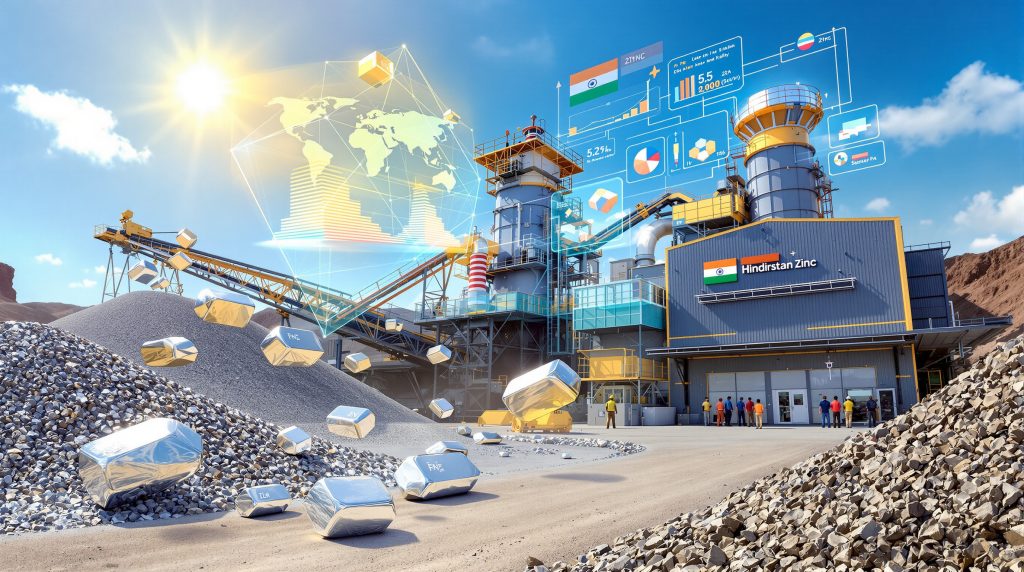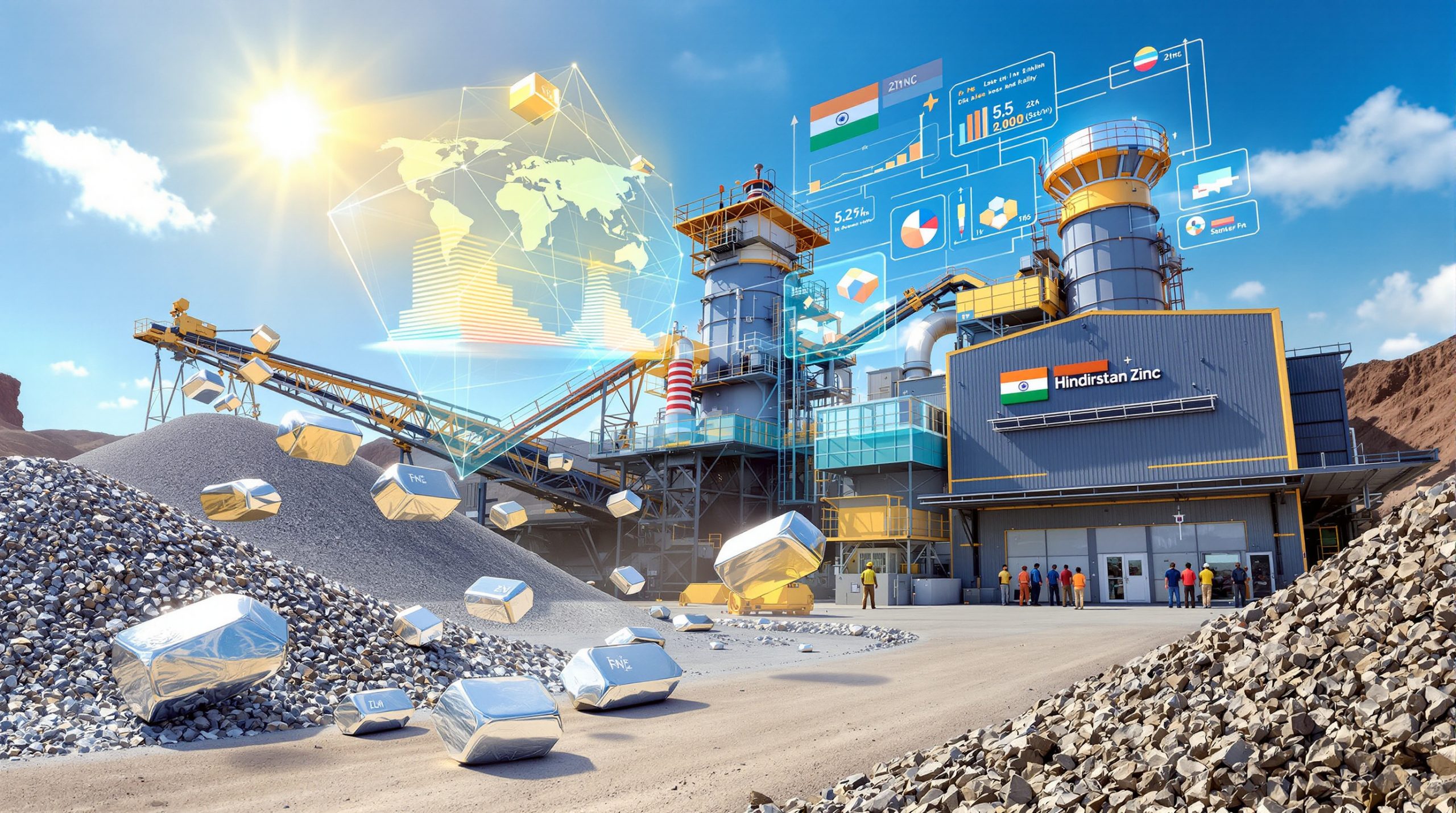Hindustan Zinc's $438 Million Investment Transforms Mining Waste into Treasure
In a significant move toward sustainable mining practices, Hindustan Zinc has announced a substantial investment of 38.23 billion rupees (approximately $437.5 million) to establish a state-of-the-art tailings reprocessing plant. This strategic initiative aims to extract valuable metals from materials previously considered waste, demonstrating how modern technology can transform resource recovery in the mining industry.
Understanding the $438 Million Reprocessing Plant Initiative
The newly announced facility represents one of Hindustan Zinc's most ambitious sustainability projects to date. This investment forms a critical component of the company's broader capacity expansion strategy, focusing on maximizing resource utilization from existing operations rather than solely expanding new mining activities.
The plant will incorporate cutting-edge processing technology specifically designed to extract valuable metals from tailings dumps – the waste material that remains after initial ore processing. These tailings often contain significant mineral content that wasn't economically recoverable using previous generation technologies.
"This investment demonstrates our commitment to sustainable mining practices while simultaneously boosting production capacity," according to a company statement released alongside the announcement. "By reprocessing materials we've already mined, we're extending the life of our resources while reducing environmental impact."
Key Technical Specifications of the Plant
The new facility will feature an impressive processing capacity of 10 million tons per annum, positioning it among the largest tailings reprocessing operations not only in India but across the global mining sector. This scale reflects both the volume of available tailings material and Hindustan Zinc's confidence in the economic viability of the project.
The plant will employ advanced flotation technology, hydrometallurgical processes, and precision sensors to identify and extract minerals that remained in tailings after initial processing. These technological capabilities represent a significant advancement in resource recovery efficiency compared to conventional mining operations.
Industry experts note that modern reprocessing plants typically achieve 30-60% recovery of remaining metals in tailings, depending on material composition and specific technologies employed. While Hindustan Zinc hasn't released specific recovery projections, similar facilities have demonstrated considerable success in extracting additional zinc, lead, and silver from previously processed materials.
Why is Tailings Reprocessing Important for Mining Companies?
The Economic Value of Reprocessing Mining Waste
Mining waste reprocessing represents a paradigm shift in how mining companies approach resource utilization. Tailings dumps often contain substantial quantities of valuable metals that weren't economically recoverable using older processing technologies. Modern extraction methods now make it viable to recover these previously inaccessible resources.
For mining companies, this creates a secondary revenue stream from material once considered depleted. The economics are particularly compelling because:
- The material has already been mined and crushed, eliminating these substantial cost components
- No additional exploration costs are required
- Infrastructure and logistics systems are typically already in place
- Lower energy requirements compared to processing virgin ore
- Reduced environmental remediation costs for tailings storage facilities
In essence, tailings reprocessing allows mining companies to "mine" their waste – extracting additional value from investments already made while simultaneously addressing environmental challenges.
Environmental Benefits of Tailings Reprocessing
Beyond the compelling economics, tailings reprocessing delivers substantial environmental advantages that align with increasing regulatory pressure and stakeholder expectations for sustainable mining transformation trends:
- Reduced waste footprint: By processing 10 million tons of tailings annually, Hindustan Zinc will significantly decrease the volume of stored waste material, minimizing land usage and environmental risks.
- Contamination prevention: Proper reprocessing reduces the risk of acid mine drainage and heavy metal leaching from stored tailings into groundwater systems.
- Decreased new mining requirements: Every ton of metal recovered from tailings potentially represents one less ton that needs to be extracted through new mining activities.
- Lower overall environmental impact: Reprocessing generally requires less energy, water, and chemicals per unit of metal produced than conventional mining and processing.
- Rehabilitation opportunities: After reprocessing, the remaining material often has reduced contaminant levels, making final site rehabilitation more straightforward.
In regions with growing environmental concerns about mining impacts, these benefits can significantly improve a company's social license to operate and regulatory relationships.
How Will This Investment Impact Hindustan Zinc's Operations?
Projected Increase in Metal Recovery Rates
According to the company's statement, the new plant will significantly boost Hindustan Zinc's overall mineral recovery capabilities. While specific percentage increases haven't been disclosed, similar facilities in the global mining industry have demonstrated recovery improvements of 3-8% for primary metals and even higher percentages for secondary metals and by-products.
For a company of Hindustan Zinc's scale, even a modest percentage improvement in recovery rates translates to substantial production increases. The enhanced recovery efficiency directly contributes to higher production volumes without expanding traditional mining operations.
"Recovering additional metal from existing tailings allows us to boost production without increasing our mining footprint," the company noted in their announcement. "This approach optimizes resource utilization while supporting our sustainability goals."
Strategic Alignment with Expansion Goals
This $438 million investment aligns perfectly with Hindustan Zinc's broader capacity expansion strategy. The company has been systematically increasing its production capabilities to meet growing domestic and regional demand for zinc, lead, and silver.
The reprocessing plant represents a particularly intelligent approach to growth for several reasons:
- Resource efficiency: Maximizes output from existing resources rather than solely focusing on new extraction sites
- Speed to market: Often faster to implement than developing new mines
- Risk mitigation: Lower geological and regulatory risks compared to greenfield projects
- Capital efficiency: Typically provides better returns on invested capital than new mine development
- Sustainability alignment: Supports corporate environmental goals and stakeholder expectations
Industry analysts note that companies successfully implementing tailings reprocessing often see enhanced operational flexibility, with the ability to blend recovered materials with primary production to optimize feed quality and processing efficiency.
What Does This Investment Mean for India's Mining Sector?
Strengthening India's Position in Global Zinc Production
India currently ranks among the world's significant zinc producers, with Hindustan Zinc being the country's only integrated zinc producer. This investment will likely strengthen India's position in global zinc markets by increasing domestic production capacity without requiring new mining permits or exploration activities.
The enhanced output could potentially reduce import dependencies for zinc and related metals, improving the country's trade balance in these critical industrial materials. With global zinc demand projected to grow at approximately 2.1% annually through 2030, primarily driven by galvanizing for construction, infrastructure, and automotive applications, this capacity expansion positions India to capture a larger share of this growth.
Zinc's critical importance in corrosion protection, particularly in infrastructure development, aligns perfectly with India's ongoing infrastructure modernization efforts. Domestic production increases help insulate these projects from international price volatility and supply chain disruptions.
Setting New Standards for Resource Efficiency
The scale and technological sophistication of this reprocessing plant could establish new benchmarks for mineral beneficiation insights in India's mining sector. As other mining companies observe the economic and environmental benefits demonstrated by Hindustan Zinc, similar investments in tailings reprocessing may follow.
This potential ripple effect could transform how India's mining industry approaches waste management and resource recovery. The technology and operational expertise developed through this project may spill over to other mineral sectors, including iron ore, bauxite, and copper mining operations across the country.
For India's broader sustainability goals, the project demonstrates how modern mining can align with circular economy principles – recovering materials that would otherwise remain as waste while reducing environmental footprints.
What Technology Will the Reprocessing Plant Utilize?
Advanced Metal Recovery Techniques
Modern tailings reprocessing facilities employ sophisticated technologies that far surpass the capabilities available when the original ore was processed. While Hindustan Zinc hasn't released specific technical details, comparable facilities typically utilize:
- Enhanced flotation processes: Using advanced reagents and micro-bubble technology to selectively recover fine mineral particles
- High-intensity leaching: Employing optimized chemical solutions to dissolve target metals from complex matrices
- Advanced separation technologies: Including spiral separators, high-frequency screens, and density separation equipment
- Precision monitoring systems: Utilizing real-time sensors to continuously adjust processing parameters for maximum recovery
These technologies enable the recovery of metals at concentrations that were previously considered uneconomical, dramatically improving resource utilization efficiency. Recovery rates that would have been impossible just 15-20 years ago are now commercially viable, opening vast tailings resources to productive use.
Automation and Digital Integration
Contemporary reprocessing facilities feature high levels of automation and data-driven mining operations, often serving as showcases for mining technology innovation. These typically include:
- AI-powered process optimization: Machine learning algorithms that continuously adjust processing parameters to maximize recovery
- Digital twin modeling: Real-time simulation of plant operations to predict outcomes and optimize performance
- Advanced process control systems: Maintaining precise conditions throughout the recovery process
- Integrated monitoring networks: Tracking material movement, energy usage, and environmental parameters
This technology integration optimizes recovery rates, reduces operational costs, and minimizes environmental impacts through precise process control. The data generated also provides valuable insights for continuous improvement and optimization of both the reprocessing facility and primary mining operations.
What are the Financial Implications of This Investment?
Return on Investment Projections
While Hindustan Zinc hasn't disclosed specific ROI figures, tailings reprocessing projects typically offer attractive returns due to their unique cost structure and value proposition. Industry benchmarks suggest projects of this nature often achieve:
- Payback periods: Typically 3-5 years, significantly shorter than new mine developments
- Operating margins: Often 10-15% higher than conventional mining due to lower extraction costs
- Capital efficiency: Better returns on invested capital compared to greenfield projects
The $438 million investment represents a significant capital commitment, indicating Hindustan Zinc's confidence in the project's financial viability. The company's strategic focus on this project suggests internal projections show compelling economics.
Investment Perspective: "Mining companies globally are increasingly recognizing that their tailings aren't just waste – they're valuable resources that modern technology can transform into profit centers while addressing environmental liabilities," notes a mining investment analyst from a leading financial institution.
Impact on Company Valuation
Major capacity expansion projects often positively influence investor perceptions and company valuations, particularly when they demonstrate sustainable growth strategies. This investment showcases Hindustan Zinc's commitment to:
- Resource optimization: Extracting maximum value from existing assets
- Technological leadership: Implementing cutting-edge processing capabilities
- Environmental responsibility: Reducing waste footprint while boosting production
- Strategic growth: Expanding capacity through innovative approaches
These factors typically resonate well with modern investors focused on both financial returns and environmental responsibility. Companies successfully implementing tailings reprocessing often trade at premium valuations compared to peers who rely solely on traditional mining expansion.
The project also potentially reduces long-term environmental liabilities associated with tailings storage, which can positively impact balance sheet strength and risk assessment.
How Does This Project Compare to Global Mining Trends?
Growing Focus on Circular Economy Principles
Hindustan Zinc's investment aligns perfectly with the global mining industry's increasing adoption of circular economy principles. Leading mining companies worldwide are implementing similar projects to extract maximum value from existing resources while minimizing environmental footprints.
This approach represents a fundamental shift in mining philosophy – from the traditional linear "extract, process, dispose" model to a more circular approach where materials flow through multiple recovery cycles.
Global mining leaders increasingly view tailings not as waste but as "mineral resources" with different processing requirements. This perspective shift is driving significant investment in recovery technologies and creating entirely new business models within the mining sector.
Comparison with Other Major Tailings Projects
Several global mining giants have launched comparable initiatives that provide useful benchmarks for Hindustan Zinc's project:
| Company | Location | Capacity (mtpa) | Primary Metals | Investment |
|---|---|---|---|---|
| Rio Tinto | Queensland, Australia | 8 | Copper, Gold | $400M |
| Glencore | Peru | 14 | Zinc, Lead, Silver | $590M |
| BHP | Chile | 12 | Copper | $520M |
| Teck Resources | British Columbia | 7 | Zinc, Lead | $350M |
| Hindustan Zinc | India | 10 | Zinc, Lead, Silver | $438M |
Hindustan Zinc's 10 million ton annual capacity places this project among the larger-scale tailings reprocessing initiatives globally. The investment scale appears consistent with industry benchmarks for facilities of similar size and technological sophistication.
What distinguishes successful projects in this space is typically not just scale but technological implementation and integration with existing operations. Companies that effectively blend recovered materials with primary production often achieve the best overall results.
What Environmental Impact Will the Plant Have?
Reducing Tailings Storage Requirements
By reprocessing 10 million tons of tailings annually, the plant will significantly reduce the volume of stored waste material. This reduction minimizes the land area required for tailings storage and decreases associated environmental risks like potential contamination or structural failures.
Based on typical industry metrics, this level of processing could reduce final tailings volume by approximately 15-20%, depending on mineral content and process efficiency. Over a decade of operation, this represents a substantial reduction in environmental footprint.
The reduction in stored tailings volume also decreases long-term monitoring and maintenance requirements, as well as potential mine reclamation innovation costs associated with tailings management.
Water and Energy Considerations
Modern reprocessing facilities typically incorporate water recycling systems and renewable energy solutions to minimize resource consumption. While specific details on Hindustan Zinc's facility design aren't available, industry best practices that would likely be incorporated include:
- Closed-loop water systems: Recycling 80-90% of process water to minimize freshwater requirements
- Energy recovery systems: Capturing waste heat and pressure for reuse within the facility
- Variable frequency drives: Reducing energy consumption by matching equipment power to actual requirements
- Renewable energy integration: Potentially incorporating solar or other renewable sources for partial power needs
These sustainability features not only reduce environmental impact but typically deliver operating cost benefits that enhance project economics.
The net environmental impact assessment typically shows tailings reprocessing projects delivering positive outcomes compared to both continued storage and new mining activities, particularly when water conservation in water-stressed regions is considered.
FAQ: Hindustan Zinc's Tailings Reprocessing Project
When will the new reprocessing plant become operational?
While Hindustan Zinc hasn't disclosed a specific timeline, projects of this scale and complexity typically require 24-36 months for construction and commissioning after final investment approval. Based on industry averages and assuming prompt regulatory approvals, the plant might reasonably be expected to begin operations by late 2028 or early 2029.
The construction timeline would likely include:
- 6-8 months for detailed engineering and procurement
- 16-20 months for construction
- 4-6 months for commissioning and ramp-up
Actual timing will depend on equipment delivery schedules, contractor availability, weather conditions during construction, and the regulatory approval process.
What metals will be recovered from the tailings?
While Hindustan Zinc hasn't specified target metals, the company's existing operations focus primarily on zinc, lead, and silver production. Based on typical mineral associations in these deposits, the reprocessing plant will likely concentrate on recovering:
- Primary metals: Additional zinc and lead minerals that weren't economically recoverable in initial processing
- Precious metals: Silver and potentially trace gold content
- By-products: Possibly including copper, cadmium, and other valuable trace elements
The specific recovery targets would be determined by detailed analysis of tailings composition and economic modeling of recovery costs versus metal values.
How will this investment affect Hindustan Zinc's production costs?
Tailings reprocessing typically offers lower production costs compared to primary mining operations due to several factors:
- Eliminated mining costs: No drilling, blasting, or hauling expenses
- Reduced crushing requirements: Material is already at a reduced particle size
- Infrastructure leverage: Utilizing existing site facilities and infrastructure
- Simplified permitting: Often faces fewer regulatory hurdles than new mining
Industry benchmarks suggest production costs from tailings reprocessing can be 30-50% lower per unit of metal recovered compared to conventional mining, though exact figures vary based on specific project characteristics.
The investment should improve Hindustan Zinc's overall cost efficiency by increasing metal output without proportional increases in mining expenses, potentially lowering the company's average production cost per ton.
What percentage increase in metal recovery is expected?
Specific recovery increase percentages weren't disclosed in Hindustan Zinc's announcement. However, modern tailings reprocessing technologies typically achieve recovery rates of:
- Zinc: 30-60% of remaining zinc content in tailings
- Lead: 25-55% of remaining lead content
- Silver: 40-70% of remaining silver content
The actual recovery percentages will depend on:
- Original processing methods used when the tailings were created
- Mineral composition and complexity of the tailings material
- Specific technologies deployed in the new facility
- Economic cutoff grades based on operating costs and metal prices
These recovery rates, applied to 10 million tons of tailings annually, could represent a meaningful production increase without additional mining activity.
Sustainable Mining: A Path Forward
Hindustan Zinc's $438 million investment in tailings reprocessing represents more than just a capacity expansion – it signals a fundamental shift in how mining companies approach resource utilization. By extracting additional value from materials previously considered waste, the company demonstrates how modern technology can transform mining's environmental and economic equation.
As global demand for metals continues to grow, driven by energy transition technologies, infrastructure development, and industrialization, the mining industry faces dual pressures to increase production while reducing environmental impact. Tailings reprocessing offers a compelling solution to this challenge, allowing companies to boost output while actually decreasing their ecological footprint.
For investors, communities, and policymakers, projects like Hindustan Zinc's reprocessing plant illustrate the potential for innovation to align economic and environmental objectives in the mining sector. As this approach gains traction globally, it may fundamentally reshape perceptions of mining's role in a sustainable future.
Disclaimer: This article contains information about an investment project that may be subject to various risks and uncertainties. The timeline, production projections, and economic outcomes discussed represent typical industry patterns but may differ in actual implementation. Readers should not construe this information as investment advice.
Want to Know When the Next Major Mineral Discovery Happens?
Don't miss out on lucrative investment opportunities like Hindustan Zinc's impressive waste-to-treasure innovation. Discovery Alert's proprietary Discovery IQ model instantly notifies you of significant ASX mineral discoveries, helping you capitalise on potentially transformative opportunities before the market fully responds. Visit our discoveries page to see how major mineral finds have historically delivered exceptional returns.




